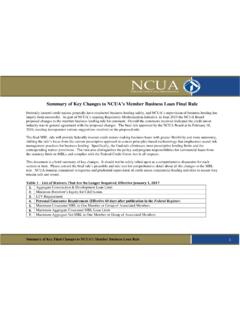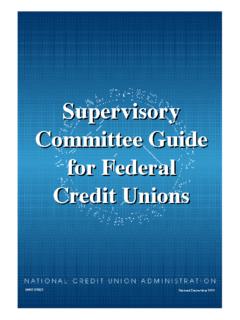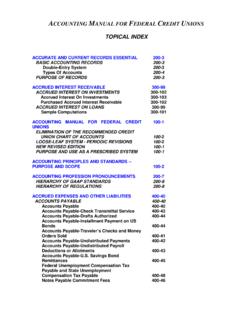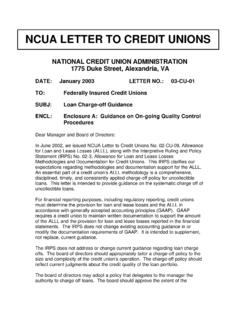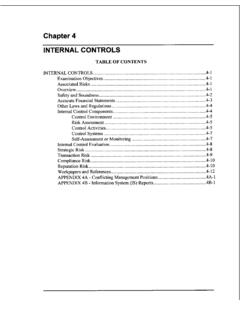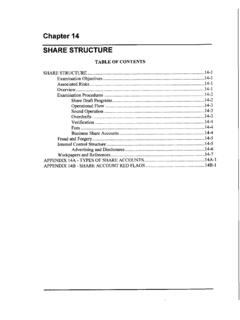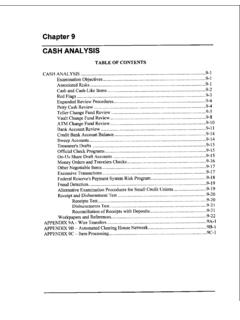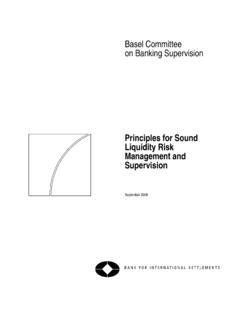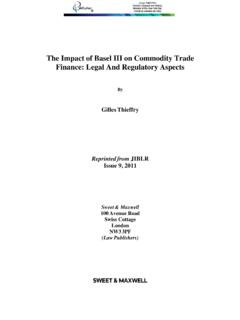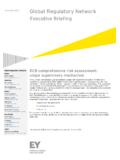Transcription of Sup Letter 08-01 - National Credit Union …
1 Supervisory Letter Concentration Risk Credit Union officials and management have a fiduciary responsibility to identify, measure, monitor, and control concentration risk. Concentration risk must be managed in conjunction with Credit , interest rate and liquidity risks; as a negative event in any category may have significant consequences on the other areas, as well as strategic and reputation risks. Concentration risk has increased in importance during the recent economic recession. Poor risk management of residential and commercial mortgage loan concentrations, in particular, is having an adverse effect on Credit unions nationwide; resulting in significant loan losses, earnings deterioration, capital depletion, and increased Credit Union failures. Most of the recent large losses to the National Credit Union Share Insurance Fund (NCUSIF) are due to poor management of large concentrations in various asset classes in relation to the asset size and net worth level of the failed institutions.
2 What is concentration risk? A risk concentration is any single exposure or group of exposures with the potential to produce losses large enough (relative to capital, total assets, or overall risk level) to threaten a financial institution s health or ability to maintain its core Avoiding concentrating too much in any single product or service is a core tenet of effective risk management and when violated increases the risk of loss to the Credit Union and to the NCUSIF. Too much reliance on any single product or service increases the potential for adverse consequences from event risk ( a negative event, such as a housing market crash, that significantly affects the financial condition of the institution). Every asset, liability, product, service, and third party provider presents a risk of loss to the Credit Union under varying conditions or events. Some risks are less likely than others to occur. It is up to Credit Union management to identify the risk in each product or service line, quantify the risk and set appropriate concentration limits based on the analysis.
3 1 Basel Committee on Banking Supervision Historical experience shows that concentration of Credit risk in asset portfolios has been one of the major causes of bank distress. Basel Committee on Banking Supervision Supervisory Letter Page 2 What are some types of concentration risk? Concentration risk is present in many forms across Credit Union operations. Examples include: Asset classes ( residential real estate loans, member business loans, automobile loans, loan participations or investments). Concentrations within a class of assets. Examples include, but are not limited to: o Residential Real Estate Loans collateral type, lien position, geographic area, non-traditional terms (such as interest-only, payment option, or balloon payment), fixed or variable interest rate, low or reduced underwriting documentation, and loan-to-value (LTV). o Member Business Loans (MBLs) types of loans ( real estate, working capital, and Credit cards), collateral type, payment feature (such as interest-only, balloon payments), loan term, geographic area, and LTV.
4 O Loan Participations types of loans ( residential real estate, MBL, and automobile) and the sub-classes associated with the types, originating lender, and geographic area. o Loans to one borrower or associated group of borrowers (may include several different types of loans residential real estate, MBLs, consumer loans, etc). o Investments types of investments ( Treasury securities, certificates of deposit, and mortgage-backed securities), collateral type, interest rates, issuer (public or private), tranche priority, and broker. Liabilities ( rate sensitive share deposits or callable borrowings). Third-party providers ( CUSOs, indirect loan partners or mortgage brokerage firms). Services provided to other parties ( loan underwriting and/or servicing, insurance services, and investment consultation). When reviewing the types of concentrations in a Credit Union , examiners must be cognizant of other asset categories that may seem unrelated. For instance, the types of loans and characteristics of the loans may be one form of concentration risk that is easily identified.
5 However, similar characteristics may exist in a loan participation portfolio or an investment portfolio. A clear example of this concept would be a Credit Union that holds a portfolio of real estate loans and also a portfolio of mortgage backed securities. There are common event risks in these types of assets that must be quantified and mitigated by management. Supervisory Letter Page 3 What are the largest exposures (risk concentrations) in Credit unions? Concentration in Credit portfolios is considered to be the most significant source of risk to financial institutions. Trends in Credit Union balance sheets reflect increased exposure to concentration risk in areas of their Credit portfolios, such as: Real estate loans (fixed rates) As of December 31, 2009, real estate loans held by Credit unions comprise 54 percent of total loans. Of the $217 billion in first mortgage loans, over 60 percent have fixed rate terms. In addition, fixed rate first mortgage loans have increased by 55 percent since 2005.
6 Member business loans As of December 31, 2009, member business loans totaled $35 billion. Credit unions grew their member business loan portfolios by percent in 2009. Loan participations As of December 31, 2009, Credit Union participations outstanding totaled $ billion, and participation lending increased by percent in 2009. Construction and Development (C&D) loans As of December 31, 2009, Credit unions owned $ billion in commercial and residential C&D loans. While this trend has declined since 2007, the real estate market downturn could continue to have an adverse effect on Credit unions with concentrations of C&D loans in their portfolio. Investments in Mortgage-Related Securities As of December 31, 2009, Credit Union investments in mortgage-related securities totaled $ billion; which is in addition to the real estate loan exposure stated above. Investments in mortgage-related securities have more than doubled since 2005. How is concentration risk identified and measured?
7 Each product or service carries some risk of financial exposure or loss for the Credit Union . Management needs to perform a risk assessment which demonstrates their understanding of the risk of the product or service, quantifies the potential loss exposure, and documents a rational business decision on the acceptable concentration level based on the analysis. The larger the concentration level, the more robust and advanced the analysis and risk management techniques should be. For instance, the sophistication and depth of risk management systems and analysis conducted on a real estate portfolio that represents 20 percent of total loans could be acceptably less than a real estate portfolio that represents 50 percent of total loans. Another example is the level of due diligence conducted on a third party service provider. The more important the service to the core operation of the Credit Union and the higher the amount of activity and dollar volume of Credit Union activity it handles, the more sophisticated and robust the due diligence oversight needs to be.
8 Supervisory Letter Page 4 Similar to the depth and sophistication of the initial review, management must increase the intensity and depth of on-going monitoring and review of products and services with high concentrations. To measure and monitor concentration risk, Credit unions must start with the systems used to store and analyze their data. For more complex products, establishing comprehensive data warehousing will allow management to track changes in the quality of their various lines of business over time. Without an all-inclusive process to maintain and analyze data, the board of directors and senior management will not have the tools necessary to make strategic and operational decisions in a safe and sound manner. Maintaining Comprehensive and Accurate Data Credit Union management must emphasize the importance of maintaining comprehensive and accurate data for each risk area. This includes a quality control function to ensure that data entry and changes are accurate and timely.
9 The Credit Union should have a data processing system capable of warehousing data on various lines of business, commensurate with its size and complexity, to properly identify and measure concentration risk. For example, this would include maintaining information relevant to the loan portfolio such as loan type, interest rate, interest rate reset dates (if applicable), payment amount, payment shock (the potential increase in payment from an interest rate reset or conversion from interest-only to principal and interest payments), Credit score (including original and updated periodically), collateral description, and collateral value (including original and updated periodically). Another example would include maintaining information relevant to the investment portfolio such as type, interest rate, collateral information, market value (original and updated periodically), and external rating (original and updated periodically). This is not an all-inclusive list, but rather a starting point for evaluating if the data processing system is capable of maintaining this type of data.
10 If the Credit Union does not have the data processing capability, management should contract with a third party to provide data warehousing and reporting. If management elects to pursue this route, examiners should review their initial and ongoing due diligence of the vendor to ensure it is in accordance with published guidance and safe and sound business practices. Risk Rating System Developing an effective, accurate, and timely risk rating system is an important tool for managing concentration risk in the loan portfolio. Risk ratings should be objective, sensitive to changes in borrower and/or loan characteristics, and validated via an independent review function. With loan participations, Credit unions should assess the loan utilizing their own internal rating system. In the absence of an internal rating system, management should not rely on the originating institution s system without completing timely, thorough, and ongoing due diligence of that system. Examiners Supervisory Letter Page 5 should review management s documentation of the original and ongoing due diligence; ensuring that it is consistent with safe and sound business practices.

